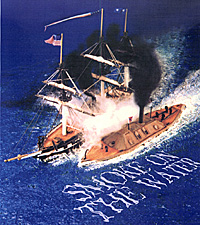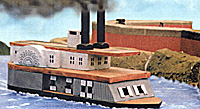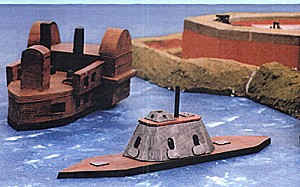The naval side of the Civil War has fascinated me since I began playing Yaquinto's IRONCLADS boardgame twenty years ago. Then, a decade ago at Historicon, I played in an extremely enjoyable game of Mobile Bay using 15mm wooden ship models and a rules set called COMMAND OF SOUTHERN WATERS.
At the same con I saw Thoroughbred's 1:600 ship
models, and then later the not-quite-as-nice-but-
cheaper-and-fill-in-some-gaps models by Peter
Pig, and I was hooked. The past several years
have combined the purchase and painting of
dozens of ships with a prolonged search for the
ideal set of rules. I have tried and enjoyed AGE
OF IRON and HAMMERIN' IRON, and I have
cobbled together my own rules using data and
concepts from all of the above; but none of
these completely suited me. I believe now,
however, that in SMOKE ON THE WATER I
have found the rules I will stick with.
When reading accounts of Civil War
naval actions, one is struck by how many
unpredictable, lucky or unlucky, or downright
bizarre events or factors might determine the
outcome. What rules set could provide for the
MIAMI firing at the ALBEMARLE at pointblank
range, and the shell bouncing up off the
ironclad's side and landing right beside the gun
which fired it, where it explodes killing the ship's
captain? If one looks at the ships' statistics one
can see that the CSS ATLANTA might well have
been a match for the two PASSAIC-class
monitors it fought; but it ran hard aground at the
start of the battle and had to surrender with
scarcely a shot fired after the monitors steamed
into its deadzone at pointblank range. When
Admiral DuPont attacked Charleston, the North's
most powerful vessel, the NEW IRONSIDES, ran
aground directly over a huge Confederate electric
torpedo which could not be detonated because a
wagon on the beach had just run over the wire
leading to the battery.
SMOKE ON THE WATER is faithful
to this historic unpredictability. The general
philosophy of these rules reminds me of John
Hill's JOHNNY REB; the basic mechanisms of
moving and shooting are simple enough, and
outcomes are generally predictable in the middle
range of dice rolls; but there are a lot of dice rolls,
and sooner or later something weird is going to
happen. The result is an exciting, enjoyable game
which can keep the invariably outmatched
Confederate players interested even as they go
down (or up) in flames.
Ships are rated in terms of speed,
maneuverability (turning radius), and draught.
Movement is simultaneous using plots. Ramming
is very difficult to achieve in single-ship duels,
but happens fairly often in fleet actions such as
Plum Run or Memphis, and can be devastating.
(Accidental collisions are also common, and
dangerous.) Running aground is a very real
possibility in shallow water, depending on
draught and speed, and rolls for breaking free can
become quite suspenseful. Even more suspenseful is to have one's own ship locked to an enemy ship, which is on fire and has been abandoned; will you break free before the fire reaches the magazine?
Artillery fire is simultaneous and involves several rolls per shot: roll to hit, with
modifiers for distance and target size and movement; roll for location of hit; roll to see if
armor is penetrated; roll to see if shells explode. A special or critical hit calls for additional rolls.
After firing there may be tests for morale, for fires, for repairs, and so forth. just about every imaginable eventuality is possible in these rules. About the only factor missing is sharpshooter fire, which was important in some situations; but I found it easy to modify the sharpshooter rules from Yacquinto's IRONCLADS.
The game system works very well for single ship duels and small fleet actions. I have
played Memphis successfully several times, with several players per side sharing the ships (about 8 or 9 on each side). If one gives the ARKANSAS to the Rebels - it might conceivably have been there if the Confederacy had put a higher priority on finishing it - then Memphis is not a totally one-sided affair.
Plum Run demonstrated that the Rebel rams could sink the CAIRO-class ironclads, and I have
seen a Rebel victory at Memphis once (out of four playings) under these rules. I have done a BIG game of the Battle of New Orleans, which strained the rules' playability; the players claimed to enjoy it, but there was so much to do each turn that we weren't able to finish after 10 or 12 hours of play.
These rules were written by Jason Gorringe and Simon Thomas, and are published by Canis Publishing, an English firm. They are available in the US from Grandiosity and perhaps
other dealers, and cost about $25. Highly recommended by this reviewer.
Canis Publishing Langton Miniatures Sold in the USA by:
ATTACTIX BROOKHLIRST
HOBBIES CAMPAIGN
HEADQUARTERS Reviews
This article appears in MagWeb (Magazine Web) on the Internet World Wide Web. USS HARTF0RD VS. THE CSS TENNESSEE AT MOBILE BAY, 1864. 1/600 PEWTER
FIGURINES FROM THOROUGHBRED FIGURES PHOTO BYTOBY BARRETT
USS HARTF0RD VS. THE CSS TENNESSEE AT MOBILE BAY, 1864. 1/600 PEWTER
FIGURINES FROM THOROUGHBRED FIGURES PHOTO BYTOBY BARRETT
 THE QUEEN CITY: 15MM RESIN MODEL FROM MERRIMAC MINIATURES
PHOTO BY JOEL GREGORY
THE QUEEN CITY: 15MM RESIN MODEL FROM MERRIMAC MINIATURES
PHOTO BY JOEL GREGORY
 THE UNION TIMBERCLAD TYLER & THE CSS IRONCLAD ARKANSAS PHOTO BY JOEL GREGORY OF HIS 15MM RESIN MODELS MERRIMACK MINIATURES
THE UNION TIMBERCLAD TYLER & THE CSS IRONCLAD ARKANSAS PHOTO BY JOEL GREGORY OF HIS 15MM RESIN MODELS MERRIMACK MINIATURES
North Trendeal
Ladoc, Truro
Cornwall, TR2 4QQ UK
Tel +44 (0) 1726 882805
rodlangton@compuserve.com
15107 E. Hampden Ave.,
Aurora, CO 80014
Tel 303 699 3349
Fax 303 699 3428
12188 Brookhurst St.,
Garden Grove, CA 92840
Tel 714 636 3585
Fax 714 636 9150
Brookhobby@aol.com
145 E.Little Creek
Rd.,
Norfolk VA 23505
Tel 757583 9451
Fax 7575312803
CHQ@worldnet.att.net
Smoke on the Water by John McBride Review of an ACW Naval Rules Set.
Redoubt Miniatures 25mm ACW Figures
The Foundry 25mm ACW Figures
Thoroughbred Figures 25mm ACW Ships
Miniature World Maker 6mm Buildings and Terrain
Back to The Zouave No. 49 Table of Contents
Back to The Zouave List of Issues
Back to Master Magazine List
© Copyright 1998 The American Civil War Society
Other military history articles and gaming articles are available at http://www.magweb.com